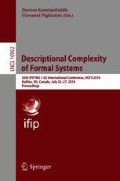Abstract
The linear space hypothesis is a practical working hypothesis, which originally states the insolvability of a restricted 2CNF Boolean formula satisfiability problem parameterized by the number of Boolean variables. From this hypothesis, it follows that the degree-3 directed graph connectivity problem (3DSTCON) parameterized by the number of vertices in a given graph cannot belong to PsubLIN, composed of decision problems computable by polynomial-time, sub-linear-space deterministic Turing machines. This hypothesis immediately implies L\(\ne \)NL and it was used as a solid foundation to obtain new lower bounds on the computational complexity of various NL search and NL optimization problems. The state complexity of transformation refers to the cost of converting one type of finite automata to another type, where the cost is measured in terms of the increase of the number of inner states of the converted automata from that of the original automata. We relate the linear space hypothesis to the state complexity of transforming restricted 2-way nondeterministic finite automata to computationally equivalent 2-way alternating finite automata having narrow computation graphs. For this purpose, we present state complexity characterizations of 3DSTCON and PsubLIN. We further characterize a non-uniform version of the linear space hypothesis in terms of the state complexity of transformation.
Access this chapter
Tax calculation will be finalised at checkout
Purchases are for personal use only
Notes
- 1.
This problem is also known as the graph accessibility problem and the graph reachability problem.
- 2.
A 2nfa with a tape head that sweeps a circular tape is called “rotating” in [9].
References
Allender, E., Chen, S., Lou, T., Papakonstantinou, P.A., Tang, B.: Width-parameterized SAT: time-space tradeoffs. Theory Comput. 10, 297–339 (2014)
Barnes, G., Buss, J.F., Ruzzo, W.L., Schieber, B.: A sublinear space, polynomial time algorithm for directed s-t connectivity. SIAM J. Comput. 27, 1273–1282 (1998)
Berman, P., Lingas, A.: On complexity of regular languages in terms of finite automata. Report 304, Institute of Computer Science, Polish Academy of Science, Warsaw (1977)
Chakraborty, D., Tewari, R.: Simultaneous time-space upper bounds for red-blue path problem in planar DAGs. In: Rahman, M.S., Tomita, E. (eds.) WALCOM 2015. LNCS, vol. 8973, pp. 258–269. Springer, Cham (2015). https://doi.org/10.1007/978-3-319-15612-5_23
Geffert, V., Mereghetti, C., Pighizzini, G.: Converting two-way nondeterministic automata into simpler automata. Theoret. Comput. Sci. 295, 189–203 (2003)
Geffert, V., Pighizzini, G.: Two-way unary automata versus logarithmic space. Inform. Comput. 209, 1016–1025 (2011)
Kapoutsis, C.A.: Minicomplexity. J. Automat. Lang. Combin. 17, 205–224 (2012)
Kapoutsis, C.A.: Two-way automata versus logarithmic space. Theory Comput. Syst. 55, 421–447 (2014)
Kapoutsis, C.A., Pighizzini, G.: Two-way automata characterizations of L/poly versus NL. Theory Comput. Syst. 56, 662–685 (2015)
Sakoda, W.J., Sipser, M.: Nondeterminism and the size of two-way finite automata. In: STOC 1978, pp. 275–286 (1978)
Yamakami, T.: The 2CNF Boolean formula satsifiability problem and the linear space hypothesis. In: MFCS 2017, LIPIcs, vol. 83, pp. 62:1–62:14 (2017). arXiv:1709.10453
Yamakami, T.: Parameterized graph connectivity and polynomial-time sub-linear-space short reductions (preliminary report). In: Hague, M., Potapov, I. (eds.) RP 2017. LNCS, vol. 10506, pp. 176–191. Springer, Cham (2017). https://doi.org/10.1007/978-3-319-67089-8_13
Author information
Authors and Affiliations
Corresponding author
Editor information
Editors and Affiliations
Rights and permissions
Copyright information
© 2018 IFIP International Federation for Information Processing
About this paper
Cite this paper
Yamakami, T. (2018). State Complexity Characterizations of Parameterized Degree-Bounded Graph Connectivity, Sub-Linear Space Computation, and the Linear Space Hypothesis. In: Konstantinidis, S., Pighizzini, G. (eds) Descriptional Complexity of Formal Systems. DCFS 2018. Lecture Notes in Computer Science(), vol 10952. Springer, Cham. https://doi.org/10.1007/978-3-319-94631-3_20
Download citation
DOI: https://doi.org/10.1007/978-3-319-94631-3_20
Published:
Publisher Name: Springer, Cham
Print ISBN: 978-3-319-94630-6
Online ISBN: 978-3-319-94631-3
eBook Packages: Computer ScienceComputer Science (R0)


